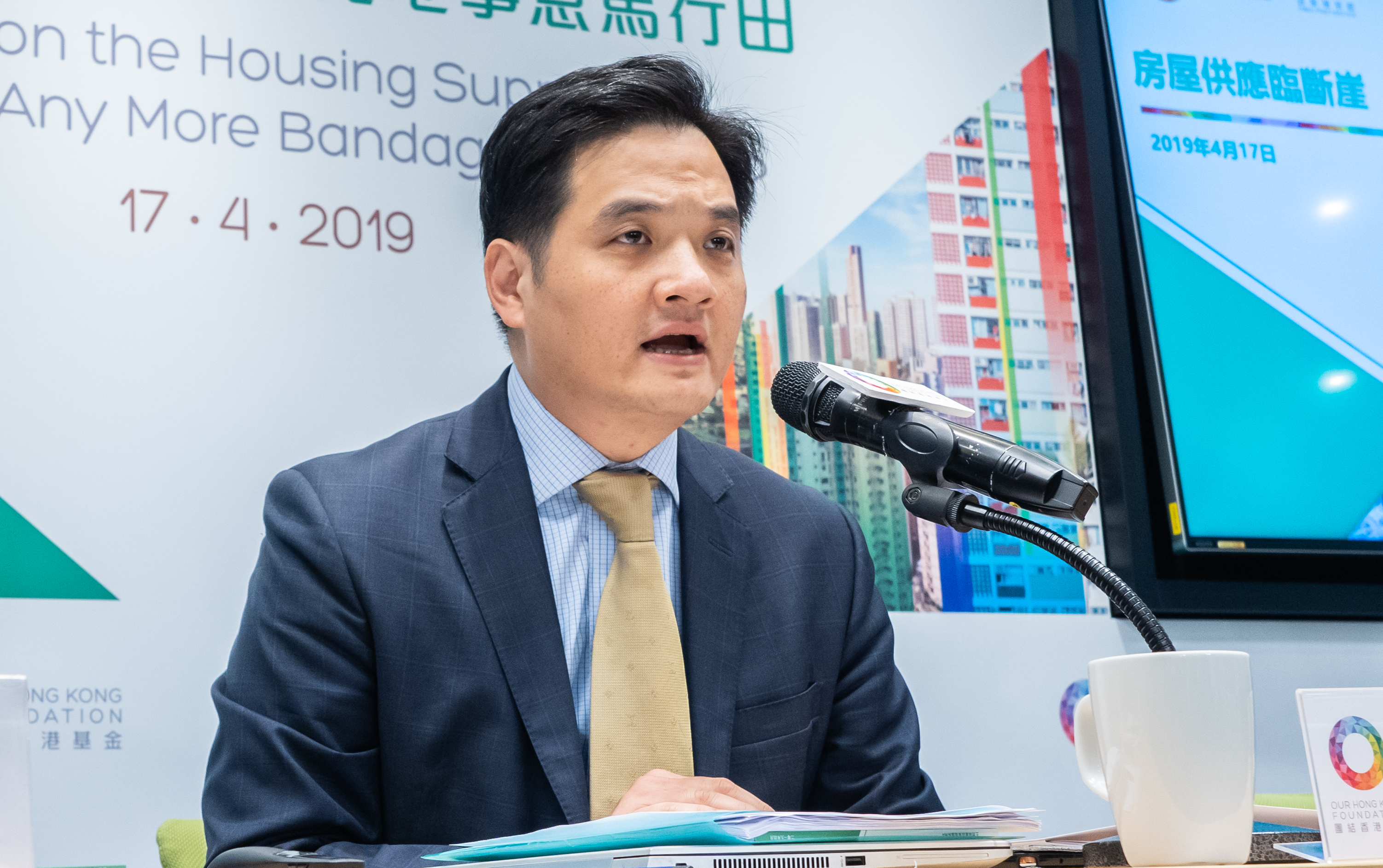Housing Drought Continues, Immediate Action in Finding Residential Land Required
Housing Drought Continues, Immediate Action in Finding Residential Land Required
Near 40% Drop in Private Housing Supply;
Public Housing Waiting Time is Expected to Exceed Six Years
OHKF Recommends Prioritising the Rezoning of 25 Sites
(17 April 2019, Hong Kong) The latest Land and Housing Policy Advocacy Report was published by Our Hong Kong Foundation (“OHKF”) today. The analysis in the report shows that the private and public housing supply will see a dramatic drop: the waiting time for public rental housing will increase to over six years in the next three years, while the number of available private residential units will drop by nearly 40% in 2023 compared to 2018.
To alleviate the current housing plight, OHKF recommends that the Government should adopt extraordinary measures to solve the housing supply crisis in the short- to medium-term:
i. Prioritise and speed up the rezoning process of 25 designated sites;
ii. Develop two sites located in Shap Sze Heung, Sai Kung with a total area of 64 hectares, which are expected to offer 20,000 to 30,000 housing units;
iii. Expedite the rezoning process for the 110 hectares of “brownfield” land and 150 hectares of privately-owned agricultural land in the New Territories.
The report also aims to educate the society about the current land shortage and initiate a more strategic and extensive assessment of the land demand as soon as possible. In addition to housing, land supply is crucial for the development of various industries, including, for example, the trading and logistics sector. As such, the Government should comprehensively assess the demand for economic ancillary land with a more forward-looking approach.
Public-Private Ratio Change Merely a “Zero-Sum Game” with a Foreseeable Plunge in the Private Housing Supply
The Government announced in the latest Long Term Housing Strategy (LTHS) Annual Progress Report that the public-private supply target ratio for newly completed housing units will be adjusted from 60:40 to 70:30. As such, the annual target for the supply of private residential units will decrease from 18,000 to 13,500 units. The OHKF report suggests that, since the total housing supply target will not be increased, the revision of the public-private ratio is merely an improvised “zero-sum game” whereas the cumulative shortfall that has resulted from a failure to meet the completion targets in the past years is unlikely to be resolved. In the past five years from 2013 to 2017, the cumulative shortfall of Hong Kong public and private housing has reached 99,000 units.
The OHKF report also states that, due to a significant slow-down in the commencement of superstructure projects in the previous year and a drastic reduction in “spade-ready sites” available for private residential development, the annual number of private residential housing units completed during 2019-2023 is estimated to be around 18,500 units, which is 11% lower than the OHKF’s estimate last year. By 2023, this figure will be further decreased to 13,300 units, i.e. a nearly 40% drop when compared to 2018.
Public Rental Housing Waiting Time will Exceed Six Years and a Cumulative Shortfall of 85,000 Units is Expected in the Next Ten Years
Although the annual public housing supply target has been adjusted upward from 28,000 to 31,500 units in the LTHS, the OHKF report estimates that in the next four years, the forecasted annual number of completed public housing units will reach only 18,300 units, which is about 42% lower than the LTHS target. In particular, by the year 2022/23, the completion number would drop sharply to 14,500 units; and over the next ten years from 2019/20 to 2028/29, a cumulative shortfall of at least 85,000 units in the public housing supply is predicted. As a result, the general applicants’ average waiting time for public rental housing will increase from the current 5.5 years to over six years in the next three years.
Prioritising the Rezoning of 25 Sites and Expediting the Development of “Unzoned Hills” are Recommended
The OHKF report states that since 2013, the Government has announced a list of 215 sites that could potentially be rezoned for residential use. However, as of January 2019, the statutory rezoning process for 69 sites has not yet begun. These sites are expected to provide a considerable amount of approximately 116,000 housing units.
After considering factors such as the transport connectivity, proximity to existing neighbourhoods and technical difficulty, OHKF has concluded that among the aforementioned sites, a selection of 25 sites could be rezoned with relative ease and should be prioritised (for details, please refer to p.72 of the Land and Housing Policy Advocacy IV: Hanging on the Housing Supply Cliff – Are There Any More Bandages Around?).
Regarding the remaining sites, another 25 are considered to be more difficult for rezoning. Among these, 60% (i.e. 15 sites) are “brownfield” sites, which will unavoidably involve complications such as land resumption, relocation and compensation as part of the development. The other 19 sites can only be assessed upon further research.
Additionally, OHKF recommended in the advocacy report published last year that “unzoned hills” should be developed. Two sites located in Shap Sze Heung, Sai Kung with a total area of 64 hectares were put forward. Since these sites belong to the Government and are situated outside country park and green belt areas, therefore they are considered suitable for short- to medium-term public housing development, offering 20,000 to 30,000 housing units. The study was well-received and based on this, OHKF was awarded the “Certificate of Excellence for the Research Team of the Year” by the Royal Institution of Chartered Surveyors (RICS), reflecting the recognition of its work by professional bodies. OHKF hopes that the Government will adopt our recommendation and further expedite the development of the relevant sites, in order to meet the urgent housing need.
Implementing TFLS Suggestions and Establishing an Inter-departmental Committee to Review the Demand for Economic Ancillary Lands are Recommended
The Government has recently adopted three short- to medium-term suggestions from the Task Force on Land Supply (TFLS). OHKF calls for the Government to take the initiative and expedite the rezoning process for the 110 hectares of “brownfield” land and the 150 hectares of privately-owned agricultural land in the New Territories, with a detailed work schedule developed accordingly. A new list of potential rezoning sites should also be announced as soon as possible.
The report also notes that economic ancillary lands such as “brownfield” sites are crucial to the growth of the trading and logistics sector, even though the economic value of these sites is often neglected by the public. The report further suggests establishing an inter-departmental committee, led by directorate officials, involving the Development Bureau, the Commerce and Economic Development Bureau, and the Transport and Housing Bureau, to thoroughly review Hong Kong’s demand for the economic ancillary lands needed for further development in the trading and logistics sector.
Improvisation is Not Enough to Solve the Supply Problem
The OHKF report further points out that Hong Kong has failed to establish an effective land bank, due to a lack of large-scale land creation and new town construction in the past decade. Although rezoning is a major source of land supply for housing development in recent years, it is not equivalent to new land creation, and social costs would be incurred. In the long run, it is necessary to increase the land supply through a multi-pronged approach that includes large-scale land reclamation.
Mr Stephen Wong, Deputy Executive Director and Head of the Public Policy Institute of OHKF, claimed that the current housing crisis “is yet to reach the bottom of the abyss”. However, our society should now focus on “making the pie bigger” rather than further dividing it. He said, “The rezoning of sites is only a short-term expedient, where the use of land changes from one purpose to another without an increase in the volume. It is just like taking a painkiller for a fever but not curing the disease. This cannot solve the problem of insufficient land supply in the long term.” He emphasised that the land and housing supply crisis has not been alleviated; therefore, different stakeholders in the society should work together to address this issue.
Mr Ryan Ip, Head of Land and Housing Research of OHKF, also noted that the housing supply is less than expected. Both the public and private housing supply will experience a cliff-edge drop in the foreseeable future. Not only will this make it more difficult for first-time buyers to purchase a property, but the waiting time for public housing will also hit a record high, which will end up lowering the quality of life for Hong Kong citizens. He urges the Government to adopt OHKF’s recommendations. “We need to prioritise the handling of the relevant 25 sites which are relatively easier to rezone, as well as developing the “unzoned hills”, in order to provide a temporary relief measure. However, we cannot just focus on discussions in such a ‘zero-sum game’ in the long run. A multi-pronged approach to increase the volume of the land supply is crucial to get out of this crisis,” he asserted.
Advocacy Report “Land and Housing Policy Advocacy Series 4: Hanging on the Housing Supply Cliff: Are There More Bandages Around?”
Chinese: http://bit.ly/2VQhpga
English: http://bit.ly/2ZiBm1h







